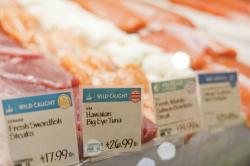Fish Rating System Helps Consumers Make Smart Decisions
September 28, 2010 | 1 min to read

Whole Foods Market Inc. has established a welcome new rating system for fish sold in its stores. It uses color codes to label fish based on their abundance and the methods used to catch them.
Other major chains have also taken steps to address concerns, increasingly expressed by marine biologists, wildlife advocates, fishermen and consumers, about overfishing and other undesirable fishing practices, such as the use of driftnets.
At Whole Foods, a green label on seafood means the species in question is not currently threatened with depletion or extinction, and is caught in ways that do not harm the species or the environment. Yellow, the middle rating, indicates there are some concerns about a species or the way it is caught.
A red label warns the consumer that the species has been overfished, and that the methods used to catch it are harmful to other species or the environment. Whole Foods says it will stop selling red-labled species entirely within three years.
To read the rest of the story, please go to: South Florida Sun-Sentinel.
